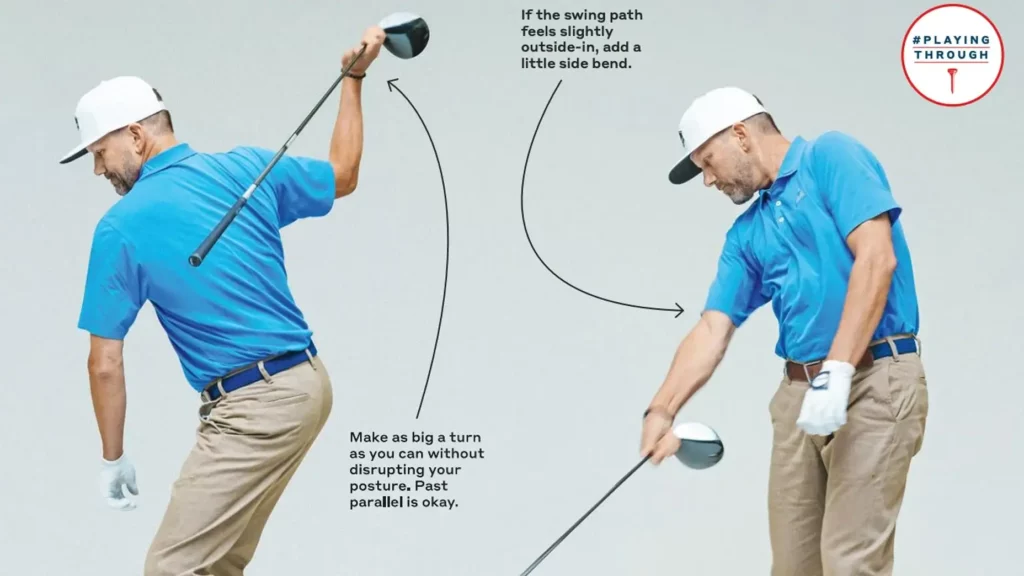Big drives are a must have if you want to compete at the highest level of your sport. But it’s hard to hit those big drives off the tee if you don’t have enough clubhead speed.
Here is a move that can help you add plenty of clubhead speed to your swing to make those drives whistle past your opponent (if they could only hear).

You’ve probably heard all the cliches, like “swing harder to improve your clubhead speed,” or “swing faster to hit it further.” That might help a little, but if you’re looking for something a bit more substantial, you won’t want to miss this post. Holding and swinging a golf club requires far more than simple strength or athleticism — that much is obvious.
But there is one thing many golfers overlook in their quest for added distance, and it has nothing to do with their muscles or reflexes. As strange as it sounds, the speed of your turn is one of the strangest secrets of all time! So if you have enough energy to finish reading this article, then you should put my findings to use on the practice range and see if they provide a breakthrough in your game.
➡ Best Golf app for Apple Watch
Extend your lead arm
If you want to increase clubhead speed, it’s essential that you extend your lead arm during the backswing. This helps max out width and puts your swing on a bigger arc.
A wider swing means more room to ramp up your clubhead speed through the impact zone. But that’s not all it takes if you want to start hitting bombs. You also need to extend your trail arm on the downswing. I’ve got a great, free-flowing drill to help you do just that.
➡ Golfshot Golf GPS – Auto Shot Tracking
Extending your lead arm during the backswing and your trail arm during the downswing is a great natural move that can help you generate more clubhead speed. But it’s not enough to increase clubhead speed as that’s a complex combination of several components including speed, consistency, rhythm, feel and trust in your swing.
➡ GolfLogix Golf GPS App for iPhone
That’s why so many good golfers have never been able to hit it past 300 yards. This is one of the reasons why I recommend golfers focus more on clubhead speed as it is more reliable than velocity and acceleration.
Improve your launch angle
You can’t gain 30 yards overnight, but there are ways to improve your swing that will increase the speed of your club and send your drives soaring. One common assumption golfers make is that increasing swing speed is the only way to hit the ball farther down the fairway.
➡ How to Improve your Golf Swing
Launch angle is known to be one of the keys to longer and more consistent shots that go further. A good launch angle can be achieved with a strong lower body and proper punching of the ball through impact. This drill will help you see what your target looks like at impact with the driver, which will help you get a better launch angle and less spin.
Improving your clubhead speed by a couple miles per hour is possible, but it usually takes years of practice and dedicated, consistent effort. If you take that approach and still fall short of your wildest driving dreams, there’s still a surefire way to increase the distance of your shots: improving your launch angle.
➡ How to practice Putting at Home
To hit the ball on a higher trajectory, you need to increase swing speed. Increased swing speed then gives you the room to play around with different launch angles and still stay under maximum carry distance. To build more clubhead speed, most amateur golfers need to lower their handicap first before they can increase their swing speed.
The inability to manage handicap is why most amateurs don’t get the chance to improve their clubhead speed. If you want to get better at controlling your launch angle then start with your practice bunker shots.
Posture and trail arm
For decades, PGA teachers have taught students to make a full takeaway and “hold the shaft in your left hand” during the swing. In fact, this is a partial-swing drill we all use regularly with our players. We might even call it “Clubhead speed.” But it’s more than that.
➡ How to practice Golf at Home and at the Range
It conveys a powerful message to the transition phase of the swing: The trail arm becomes active and helps us accelerate the clubhead through impact. The right shoulder should be forced down into the back to form a clamshell — or what I often call a “t-bone set.”
Have you ever watched a top driver player and wondered what it would be like to swing the club as hard as they do? When I was growing up I watched Bernhard Langer’s full swing and tried to emulate what he did. The problem was, no matter how hard I tried, my body wasn’t co-operating with my lead arm.
In hindsight, I think that was one of the main reasons why my distance was poor. It became increasingly clear to me that you can send your arms where you want them to go on the backswing but you must let your trailing arm work for you on the downswing if you want to hit it big.
